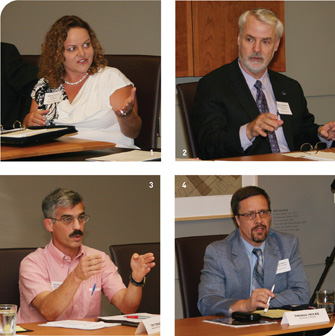
1. Community needs, as well as those of business, must be factored into graduate programs, said Janice Putnam. | 2. An interdisciplinary approach, said Dan Richardson, had helped the K-State - Olathe campus launch relevant programming. | 3. Tom Tomasi seconded the call for more community outreach by universities. | 4. Thomas Heilke noted that by allowing broader access to various levels of expertise on campus, a community’s quality of life is improved.
The Kansas State-Olathe campus has taken an interdisciplinary approach, said Dan Richardson. They have asked industry leaders to describe the skill sets they are looking for and asked faculty to discern what course offerings best fit those needs.
For Janice Putnam, associate dean of the University of Central Missouri Graduate School in Warrensburg, the perspective is a little different. She argued that it is important to engage the larger community and survey what their needs are going to be. “We’re finding we have a tremendous number of students who want the entrepreneurial courses,” she added. “They have visions of what they want to do and the services they want to supply.” Their insights help UCM understand the needs of smaller communities as well as large.
In a similar spirit, KU offers extension services throughout the state. “That’s again a kind of expertise that an institution of higher learning can bring to a wider region,” said Heilke, “and it does have all kinds of important life quality effects.”
“What we don’t do enough of is the more informal extension,” said Tom Tomasi, an associate dean at Missouri State University. Tomasi made the case for a variety of informal interactions between the faculty and the community as well as improved communications to make the community aware of the possibilities.
Communications
Sensing a natural segue, Dean George Justice asked his colleagues what they could do to establish meaningful and positive communication between the universities and the general public about the various graduate programs and their value to the community.
Venkat Allada, vice provost for Missouri University of Science and Technology, believes that a critical part of the information exchange must involve funding priorities. Allada argued for the importance of “trying to understand and
see what goes on in legislators’ minds.” They have a limited pool of money, and if they make cuts, it would pay to know why they’re made—and how.
As George Justice conceded, this is not always an easy communication. What kind of message is necessary to establish a value differential between, say, 18th-century British literature, Justice’s specialty, and coursework designed to train nurse practitioners. “We need to be more clear ourselves as graduate deans, as faculty leaders of our institutions,” he said, “as to exactly what our messages are internally as well as externally about the many things we’re trying to do.”
When the issue was raised as to the way universities interact with outside groups, Justice agreed that even a university’s neighbors often don’t know what is happening on campus. “We have this mentality that there are walls around the institutions,” he said.
Allan Rawitch believed that the best communication tools available are those charts that show the economic returns on graduate degrees. “That’s a very powerful argument,” said Rawitch, “if you project [those numbers] onto a community.” Justice saw the value in projecting that argument regionally, not just institutionally.
As a result of collaboration, Carol Shanklin believes that institutions in the region are learning how to communicate to the public exactly what they are doing in their research efforts. Just as important, students are
learning how to communicate science to the public.